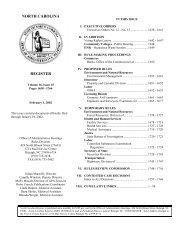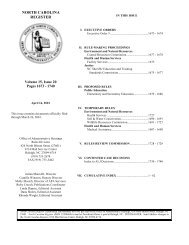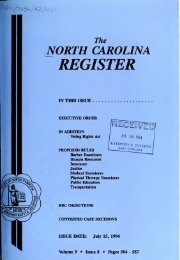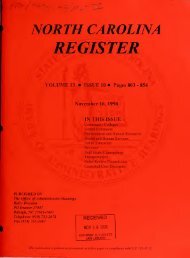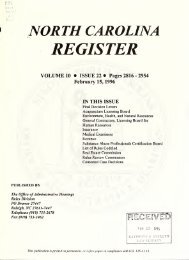NC Register Volume 21 Issue 09 - Office of Administrative Hearings
NC Register Volume 21 Issue 09 - Office of Administrative Hearings
NC Register Volume 21 Issue 09 - Office of Administrative Hearings
Create successful ePaper yourself
Turn your PDF publications into a flip-book with our unique Google optimized e-Paper software.
CONTESTED CASE DECISIONS<br />
39. The USFWS has documented a correlation between increased urban development and Carolina heelsplitter habitat<br />
degradation in the Goose Creek watershed. As urban development has increased in the upper portion <strong>of</strong> the watershed, Carolina<br />
heelsplitter habitat is being eliminated. Surveys conducted by the USFWS <strong>of</strong> Carolina heelsplitter habitat from the time <strong>of</strong> listing<br />
through 2005 show that habitat has steadily decreased as urban development has increased in the watershed.<br />
40. The federally endangered Carolina heelsplitter lives in the gravelly, rocky substrate found along the stream bed in<br />
Goose and Duck Creeks in the Goose Creek watershed. The majority <strong>of</strong> the substrate in the upper reaches <strong>of</strong> both creeks has been<br />
eroded away by increased stormwater run<strong>of</strong>f, thereby significantly reducing the available habitat for the endangered mussel.<br />
41. Pollutants, such as sediment, ammonia, phosphorus, nitrate-nitrite, and copper, found in stormwater run<strong>of</strong>f have<br />
been determined to be harmful to the Carolina heelsplitter.<br />
42. Sediment from stormwater run<strong>of</strong>f affects the Carolina heelsplitter in four ways. First, because the mussels are filter<br />
feeders, the increased sediment loading in stormwater run<strong>of</strong>f can clog their gills affecting their respiration and feeding. Increased<br />
sediment in the streams can ultimately suffocate the mussels by accumulating on top <strong>of</strong> the mussels’ habitat and burying the mussels.<br />
Second, sediment affects the stability <strong>of</strong> the stream bottom and can result in mussels being washed out <strong>of</strong> their habitat because the<br />
substrate becomes unstable. Third, other pollutants bind to sediment particles and get carried down into the substrate as the sediment<br />
settles out <strong>of</strong> the water column, thereby increasing the mussels’ exposure to the pollutant. Finally, sediment detrimentally affects the<br />
health <strong>of</strong> fish in streams. The mussels rely upon a fish host in order to reproduce by having mussel larvae attach to the fish’s gill to<br />
mature.<br />
43. Ammonia is a pollutant that has been associated with stormwater run<strong>of</strong>f and is <strong>of</strong> particular concern with regard to<br />
mussels. Ammonia is extremely toxic to freshwater mussels. Ammonia levels in the Goose Creek watershed have been identified as<br />
already exceeding the levels <strong>of</strong> concern for mussels and monitoring indicates that the levels are on an increasing trend in the<br />
watershed.<br />
44. Phosphorus and nitrate-nitrite are also associated with stormwater run<strong>of</strong>f. Both pollutants are nutrients and at<br />
excessive levels in a watershed can lead to algal blooms, which deplete the oxygen levels in the streams. Low oxygen levels<br />
detrimentally affect the Carolina heelsplitter. Algal blooms from excessive nutrient levels have been documented in the Goose Creek<br />
watershed. Monitoring in the watershed also indicates that phosphorus and nitrate-nitrite levels in the watershed are on an increasing<br />
trend.<br />
45. Copper is also a constituent in stormwater run<strong>of</strong>f and has been found harmful to mussels at high concentrations.<br />
Copper levels exceeding the concern level for mussels have been documented in the Goose Creek watershed.<br />
46. The USFWS, in conjunction with the N.C. Wildlife Resources Commission and the N.C. Natural Heritage Program,<br />
has identified measures for controlling stormwater run<strong>of</strong>f and mitigating its detrimental impacts to the Carolina heelsplitter and its<br />
habitat in the Goose Creek watershed.<br />
47. The USFWS provided Respondent with its determinations prior to the issuance <strong>of</strong> the three NPDES Phase II permits<br />
challenged in this proceeding, in the form <strong>of</strong> a letter and a draft site specific management plan.<br />
48. Based on a review <strong>of</strong> scientific literature regarding appropriate buffer widths and on the field observations <strong>of</strong> the<br />
USFWS’s own experts, the USFWS determined that two-hundred foot undisturbed riparian buffers on perennial streams and onehundred<br />
foot undisturbed riparian buffers on intermittent streams are required to protect the Carolina heelsplitter in Goose Creek.<br />
49. Based on a review <strong>of</strong> scientific literature regarding impervious surface or disturbance in the floodplain, and on the<br />
field observations <strong>of</strong> the USFWS’s own experts, the USFWS determined that impervious surface, active management, and other land<br />
disturbances, such as sewer lines and water lines, should be prohibited in the Goose Creek floodplain.<br />
50. Based on a review <strong>of</strong> scientific literature regarding impervious surface thresholds and on the field observations <strong>of</strong><br />
the USFWS’s own experts, the USFWS determined that any further increases in impervious surface in the Goose Creek watershed<br />
should be required to implement engineered stormwater controls to <strong>of</strong>fset impacts to the stream.<br />
51. Based on a review <strong>of</strong> scientific literature regarding impervious surface thresholds and on the field observations <strong>of</strong><br />
the USFWS’s own experts, the USFWS determined that water quality standards for phosphorus, nitrate-nitrite, copper, and ammonia<br />
should be in place in the Goose Creek watershed to protect the Carolina heelsplitter from toxic levels <strong>of</strong> these pollutants. For<br />
ammonia, the USFWS has determined that an acute water quality standard <strong>of</strong> 1.75 milligrams per liter and a chronic water quality<br />
standard <strong>of</strong> 0.50 milligrams per liter are necessary to protect the Carolina heelsplitter in the Goose Creek watershed. The USFWS has<br />
<strong>21</strong>:<strong>09</strong> NORTH CAROLINA REGISTER NOVEMBER 1, 2006<br />
871




